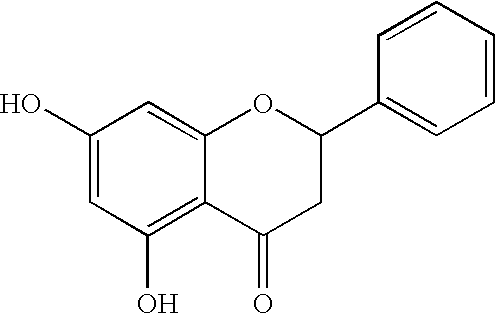Method for resolution of a mixture of pinocembrin optical isomers, especially a pinocembrin racemate
- Summary
- Abstract
- Description
- Claims
- Application Information
AI Technical Summary
Benefits of technology
Problems solved by technology
Method used
Image
Examples
example 1
Protection of Pinocembrin Phenolic Hydroxyl Group
[0042]To 100 ml acetone, 8.53 g (33 mmol) of a racemic pinocembrin powder (obtained according to the method of DUAN Yabo et al, Chinese Journal of Medicinal Chemistry, 16(6):342-346, 2006) was added, stirred and dissolved, then 5 g (36 mmol) of K2CO3 powder and 0.31 g (1.88 mmol) of KI were added thereto, stirred for 5 minutes. 5 ml (43 mmol) of benzyl chloride was added, heated with an oil bath to reflux and monitored by TLC until the completion of the reaction (about 4 h).Then stopped heating, cooled to room temperature, inorganic salts were removed by filtration under a reduced pressure, the filter cake was washed fully with acetone, then the filtrate was collected, concentrated, and purified by a common silica gel column chromatography to give a pale yellow oil product, which was solidified with light petroleum to give a solid of benzyl protected racemic pinocembrin (10.26 g, yield 89.0%).
example 2
Derivatization Reaction and Resolution
[0043]To 100 ml toluene, 19.7 g (57 mmol) of the benzyl protected racemic pinocembrin was added, stirred and then cooled to 0° C. with an ice bath. 15 ml (109 mmol) of triethylamine and 7.3 ml (57 mmol) of L-α-methylbenzylamine were dissolved in 20 ml of toluene, and the obtained mixture solution was added to the above reaction liquid, and stirred for 5 minutes. 3.25 ml (29 mmol) of TiCl4 was dissolved in 10 ml of toluene, and the obtained mixture solution was added dropwise to the reaction liquid. After 10 minutes of agitation, the ice bath was removed, and agitation was continued at room temperature. The reaction was subjected to a desiccation treatment, i.e., all instruments and reagents were dried and a N2 protection was used during the reaction. The reaction was monitored by TLC until completion (about 48 h). Stopped agitating, the reaction mixture was filtered through a funnel filled with enough Celite, the filter cake was washed fully wit...
example 3
Dederivation of Resolution Product
[0044]7.5 g of the more polar yellow oil product obtained in Example 2 was dissolved in 70 ml of a mixture solvent of ethyl acetate and ethanol in a ratio of 5:2 (V:V), stirred and heated to reflux with an oil bath, and 20 ml of 10% aqueous HCl was added in four batches (each 5 ml) with a time interval of 0.5 h for each batch. The reaction was monitored by TLC until completion (about 2.5 h). Then stopped heating, cooled to room temperature, the reaction mixture was extracted with ethyl acetate and water. The organic phase was collected, concentrated and recrystallized with 95% ethanol to give a white solid of benzyl protected pinocembrin in S-configuration (4.4 g) with specific rotation [α]D20=−30.78° (c=0.510, acetone).
PUM
| Property | Measurement | Unit |
|---|---|---|
| Fraction | aaaaa | aaaaa |
| Concentration | aaaaa | aaaaa |
| Molar ratio | aaaaa | aaaaa |
Abstract
Description
Claims
Application Information
 Login to View More
Login to View More - R&D
- Intellectual Property
- Life Sciences
- Materials
- Tech Scout
- Unparalleled Data Quality
- Higher Quality Content
- 60% Fewer Hallucinations
Browse by: Latest US Patents, China's latest patents, Technical Efficacy Thesaurus, Application Domain, Technology Topic, Popular Technical Reports.
© 2025 PatSnap. All rights reserved.Legal|Privacy policy|Modern Slavery Act Transparency Statement|Sitemap|About US| Contact US: help@patsnap.com



